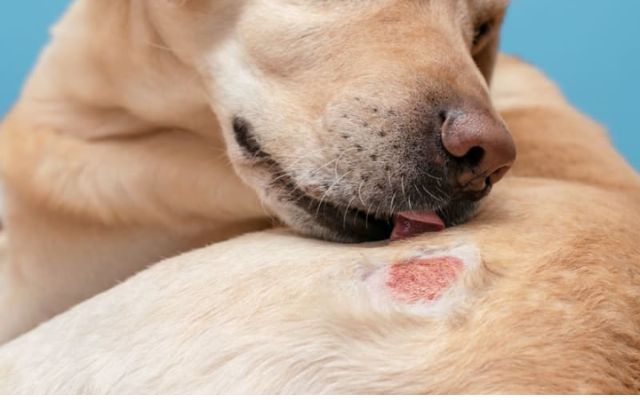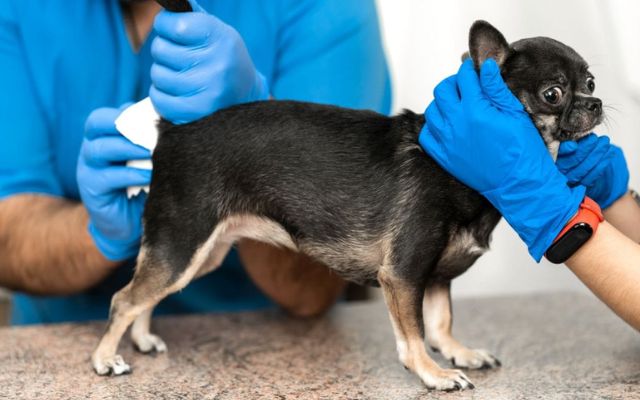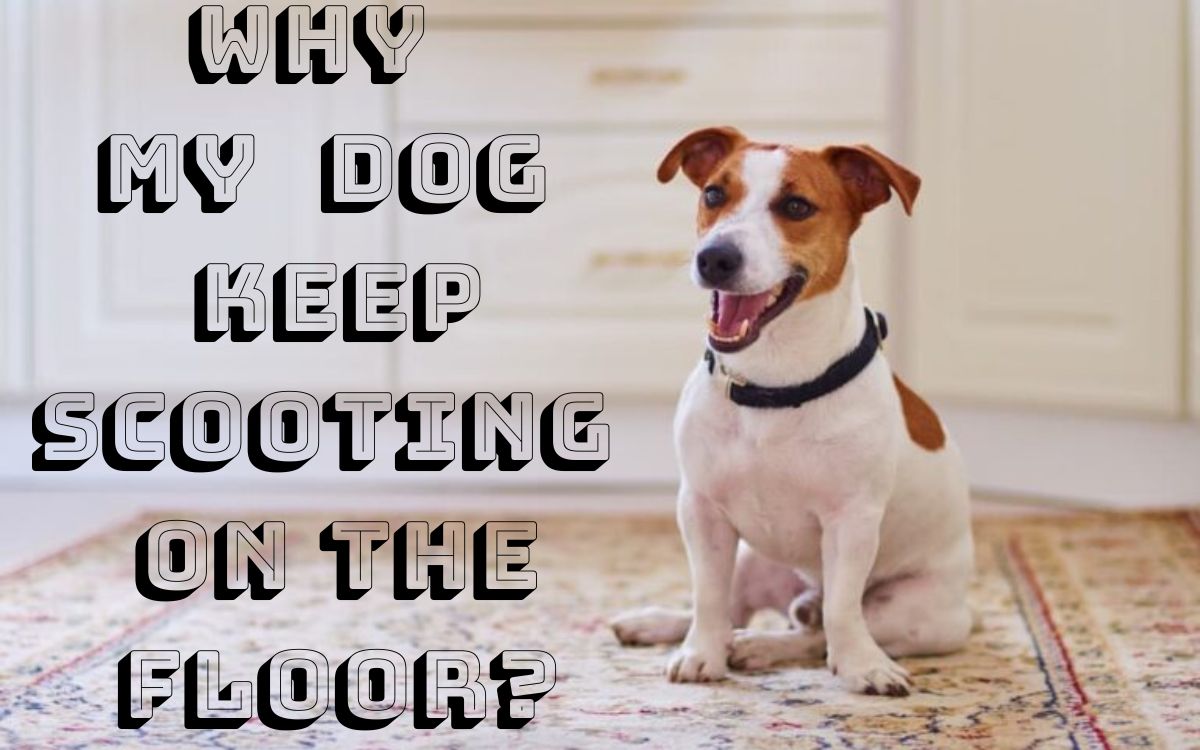Why is my dog dragging her butt across the carpet? It’s an amusing sight, but it could signal underlying issues. This seemingly quirky behavior, known as scooting, isn’t just a canine quirk—it’s often a cry for help.
In this comprehensive guide, we’ll delve into the common and uncommon reasons for dog scooting, explore preventive measures, and offer solutions to get your furry friend back to their normal, tail-wagging self. Whether it’s a minor irritation or a more serious concern, understanding the cause is crucial for effective treatment.
Let’s decode your dog’s scooting behavior and learn how to address it.

What is Dog Scooting?
Dog scooting, also known as butt scooting or sledding, refers to the act of a dog dragging its rear end across the floor or ground. It might seem humorous at first, but it’s a clear indication that something is amiss. Dogs are naturally clean animals, and scooting is their way of trying to relieve discomfort or irritation in their anal region.
How Does Dog Scooting Look?
Imagine your dog sitting down, lifting its hind legs, and propelling itself forward using its front paws. This dragging motion, often accompanied by a look of discomfort or even embarrassment, is the hallmark of scooting. Some dogs might only scoot for a few seconds, while others might engage in prolonged episodes.
The frequency and duration of scooting can offer clues about the underlying cause. Occasional scooting might simply be due to a dirty bottom, but frequent or persistent scooting often suggests a more significant issue.
Is Dog Scooting Normal?
While an occasional scoot might not be a cause for alarm, it’s not considered normal behavior. It’s crucial to pay attention to your dog’s scooting habits and investigate any underlying issues. Ignoring the problem can worsen the discomfort and potentially lead to more serious health complications.
Causes of Dog Scooting
Dog scooting can stem from various causes, ranging from minor irritations to more serious medical conditions. Recognizing the underlying reason is crucial for effective treatment. Here, we’ll delve into the most common culprits behind this peculiar behavior.
Anal Gland Problems
The most frequent reason for dog scooting is an issue with the anal glands. These small sacs located on either side of the anus produce a fishy-smelling fluid that helps dogs mark their territory and identify each other. However, these glands can become impacted or infected, causing discomfort and prompting your dog to scoot. To learn more about how Anal Gland affects your dogs, you can go read this American Kennel Club’s article: Anal Glands in Dogs: Everything You Need to Know
Impacted Anal Glands
When the anal glands don’t empty properly, the fluid thickens and accumulates, leading to impaction. This can cause itching, pain, and a foul odor. Small dog breeds, like Chihuahuas and Toy Poodles, are more prone to this issue.
Anal Gland Infection
If the impacted glands become infected, it can lead to an abscess, a painful pus-filled pocket. This condition requires immediate veterinary attention.
Signs of Anal Gland Problems:
- Scooting
- Licking or biting the anal area
- Swelling or redness around the anus
- A foul odor
- Difficulty defecating
Treatment:
- Manual expression of the anal glands by a veterinarian or groomer
- Antibiotics for infections
- Warm compresses for abscesses
- Dietary changes to promote regular bowel movements
If you want to get more information about Anal Gland Problems on Dogs, consult this article: Swollen Anus in Dogs: Causes, Symptoms & Treatment.
Skin Irritation
Skin irritation is another common cause of dog scooting. The skin around the anus is sensitive and prone to irritation from various factors, including:
- Allergies: Dogs can develop allergies to food, environmental allergens, or flea bites, causing itchy skin.
- Parasites: Mites, fleas, and ticks can irritate the skin, leading to scooting.
- Infections: Bacterial or fungal infections can cause skin inflammation and itching.
- Hot spots: These are moist, itchy patches of skin that can develop due to allergies, infections, or other irritants.
Signs of Skin Irritation:
- Scooting
- Licking or biting the affected area
- Redness, swelling, or rash
- Hair loss
Treatment:
- Identifying and eliminating the cause of the irritation
- Antihistamines for allergies
- Medicated shampoos or ointments for infections
- Flea and tick prevention medication

Intestinal Parasites
Intestinal parasites are another common cause of scooting in dogs. These pesky critters, such as roundworms, tapeworms, hookworms, and whipworms, can reside in your dog’s digestive tract, causing discomfort and irritation.
How Intestinal Parasites Cause Scooting:
While primarily residing in the intestines, these parasites can sometimes migrate to the anal area, causing intense itching and prompting your dog to scoot. Additionally, the presence of parasites can lead to diarrhea and loose stools, which further irritate the skin around the anus.
Signs of Intestinal Parasites:
- Scooting
- Diarrhea
- Vomiting
- Weight loss
- Dull coat
- Pot-bellied appearance
- Presence of worms or eggs in the stool
Treatment:
- Deworming medication prescribed by a veterinarian
- Regular fecal examinations to monitor for parasites
- Preventive measures such as monthly heartworm prevention, which often includes protection against intestinal parasites.
Food Allergies
Just like humans, dogs can develop allergies to certain foods. Common culprits include beef, chicken, dairy, wheat, and soy. These allergies can manifest in various ways, including skin irritation, itching, and scooting.
How Food Allergies Cause Scooting:
Food allergies can trigger inflammation and itching throughout the body, including the anal area. Dogs might scoot to relieve the discomfort caused by this allergic reaction.
Signs of Food Allergies:
- Scooting
- Itchy skin
- Skin rashes or hives
- Ear infections
- Gastrointestinal problems (vomiting, diarrhea)
- Chronic paw licking
Diagnosing Food Allergies:
- Elimination diet trial: This involves feeding your dog a novel protein diet (e.g., venison, rabbit, duck) for several weeks to see if the symptoms improve.
- Allergy testing: This can help identify specific allergens.
Treatment:
- Avoiding the allergen
- Feeding a hypoallergenic diet
- Antihistamines or other medications to manage the symptoms
Urinary Tract Infections
Urinary tract infections (UTIs) can also lead to dog scooting. While UTIs primarily affect the urinary system, the resulting inflammation and irritation can extend to the anal area, causing discomfort and prompting scooting.
Signs of Urinary Tract Infections:
- Scooting
- Frequent urination
- Straining to urinate
- Blood in the urine
- Licking the genital area
Treatment:
- Antibiotics prescribed by a veterinarian
- Increased water intake to flush out the bacteria
- Dietary changes to prevent future UTIs
Other Potential Causes of Dog Scooting
While the above causes are the most common, several other factors can contribute to dog scooting.
Dirty Bottom
A dirty bottom, whether due to leftover fecal matter, matted fur, or other debris, can cause irritation and lead to scooting. Regular grooming, especially for dogs with long hair, can help prevent this issue.
Stress and Anxiety
Believe it or not, stress and anxiety can manifest physically in dogs, leading to behaviors like scooting. If your dog is experiencing stress due to changes in routine, separation anxiety, or other factors, it might scoot as a coping mechanism.
Rare Causes
- Perianal fistulas: These are painful sores around the anus that require veterinary treatment.
- Rectal prolapse: This is a serious condition where the rectum protrudes from the anus.
- Anal sac tumors: Although rare, these can occur and cause discomfort.
Prevention of Dog Scooting
Preventing dog scooting involves addressing the underlying causes and taking proactive measures to maintain your dog’s health and hygiene. Here are some tips:
Maintain a Healthy Diet
- Feed your dog a high-quality, balanced diet rich in fiber. Fiber helps promote regular bowel movements and prevent anal gland issues.
- Consider adding pumpkin puree or other fiber sources to your dog’s diet.
- Avoid feeding your dog table scraps or excessive treats, as this can contribute to allergies and digestive problems.
Regular Parasite Prevention
- Administer monthly heartworm prevention medication, which often includes protection against intestinal parasites.
- Use flea and tick prevention products as recommended by your veterinarian.
- Schedule regular fecal examinations to monitor for parasites.

Anal Gland Expression (If Necessary)
- If your dog is prone to anal gland problems, your veterinarian or groomer can express the glands regularly to prevent impaction.
- Learn the signs of anal gland issues and seek professional help if needed.
Maintain Good Hygiene
- Regularly clean your dog’s anal area to remove any debris or fecal matter.
- Keep the fur around the anus trimmed to prevent matting.
- Bathe your dog regularly, especially if it has long hair.
Manage Stress and Anxiety
- Provide your dog with plenty of exercise and mental stimulation.
- Use positive reinforcement training to help your dog cope with stress.
- Consider calming supplements or pheromone diffusers if needed.
Conclusion
Dog scooting is not just an amusing spectacle; it’s a clear sign that your furry friend needs attention. As we’ve explored, the reasons behind this behavior are diverse, ranging from simple hygiene issues to underlying medical conditions.
Understanding the root cause is crucial for effective treatment and prevention. If your dog is scooting, don’t hesitate to consult your veterinarian for a thorough examination and diagnosis. Addressing the issue promptly can save your dog from unnecessary discomfort and potential complications.
By prioritizing your dog’s health, maintaining good hygiene, and addressing any underlying issues, you can help your canine companion live a happy, healthy, and scoot-free life. Remember, a happy dog is a healthy dog, and a wagging tail is always better than a scooting bottom.
FAQs
Is dog scooting always a sign of a serious problem?
While scooting often indicates an issue that needs addressing, the severity can vary. Occasional scooting might simply be due to a dirty bottom, while frequent or persistent scooting could signal a medical condition. It’s crucial to monitor your dog’s behavior and consult a vet if you’re concerned.
Can certain dog breeds be more prone to scooting due to their anatomy?
Yes, smaller dog breeds with shorter legs or those with excessive skin folds around their anus (like Bulldogs or Pugs) can be more prone to anal gland issues and subsequent scooting. This is because their anatomy can sometimes hinder natural gland expression.
Could my dog’s diet be contributing to their scooting behavior?
Absolutely. A diet lacking in fiber can lead to constipation and difficulty expressing anal glands naturally, resulting in scooting. Additionally, food allergies can cause skin irritation and itching, prompting the behavior.
Are there any natural remedies or home treatments for dog scooting that I can try?
While some home remedies like adding fiber to your dog’s diet or warm compresses for anal gland discomfort might offer temporary relief, it’s crucial to consult a vet for proper diagnosis and treatment. Underlying issues like infections or parasites require professional intervention.
Can emotional stress in my dog cause them to scoot, even if there’s no physical issue?
Yes, dogs can exhibit physical symptoms like scooting as a response to stress or anxiety. If a vet has ruled out medical causes, consider potential stressors in your dog’s environment or routine. Behavioral modification techniques and calming aids might help alleviate the issue.

Healthy dogs mean happy dogs, and that makes me happy! I’m here to share all the tips for keeping your best furry friend in top shape, from puppyhood to their golden years.

